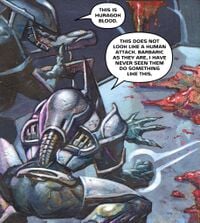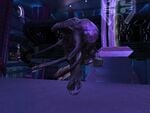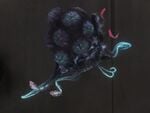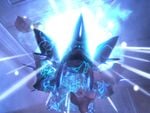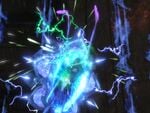Huragok: Difference between revisions
From Halopedia, the Halo wiki
SPARTAN-A110 (talk | contribs) No edit summary |
m (→Trivia: minor edit italics) |
||
| Line 106: | Line 106: | ||
*In ''Halo 3: ODST'', during the hub level [[Mombasa Streets (Level)|"Mombasa Streets"]], three Brutes can be observed torturing an Engineer. Two of the Brutes hold the creature in place while the third one violently attaches an explosive to it. Additionally, in several hidden courtyards, two Huragok can be found, on their own, shining lights on to walls, as if searching for something. If the player gets their attention, the Huragok will look at the player for a minute, then continue searching (these courtyards usually hold an Audio Log). If near these areas, the Superintendent will point the player towards them. | *In ''Halo 3: ODST'', during the hub level [[Mombasa Streets (Level)|"Mombasa Streets"]], three Brutes can be observed torturing an Engineer. Two of the Brutes hold the creature in place while the third one violently attaches an explosive to it. Additionally, in several hidden courtyards, two Huragok can be found, on their own, shining lights on to walls, as if searching for something. If the player gets their attention, the Huragok will look at the player for a minute, then continue searching (these courtyards usually hold an Audio Log). If near these areas, the Superintendent will point the player towards them. | ||
*In ''[[Midnight in the Heart of Midlothian]]'', [[Mo Ye]] incorrectly states that the Covenant "call them Engineers". "Engineer" is actually the Human name for the species, with the Covenant name being Huragok. | *In ''[[Midnight in the Heart of Midlothian]]'', [[Mo Ye]] incorrectly states that the Covenant "call them Engineers". "Engineer" is actually the Human name for the species, with the Covenant name being Huragok. | ||
*In Halo: Reach, Engineers do not explode like they do in [[Halo 3: ODST]]. | *In ''Halo: Reach'', Engineers do not explode like they do in ''[[Halo 3: ODST]]''. | ||
*The abuse towards this species by the [[Brutes]] may have lead them to join the Covenant Separatists after the end of the [[Human-Covenant War]]. | *The abuse towards this species by the [[Brutes]] may have lead them to join the Covenant Separatists after the end of the [[Human-Covenant War]]. | ||
Revision as of 23:54, September 24, 2010
| This article does not have enough inline citations and/or does not adhere to the proper citation format. You can help Halopedia by adding citations. |
Template:Covenant Species Infobox
- "A sentient labor-saving device with the ability to self-repair and self-replicate. Good with computers."
- — Bungie.net description of Huragok
Huragok (Latin Facticius indoles[1], meaning "artificial genius"[2]), known to Humans as Engineers,[3] are a race of biological supercomputers that was created by the Forerunners.[1] They are the only known non-combatant race of the Covenant, though some are rigged to explode like suicide bombers.
Description
While it is generally held that only the San 'Shyuum are high enough in the Covenant Hierarchy to handle and manage Forerunner research and technology, in reality it is the Huragok who must excavate, unlock, and transport Forerunner artifacts (a fact only known to higher ranked officers and leaders within the Covenant, due to its sensitive nature), though the San 'Shyuum insist that any admission of that fact is heresy.[citation needed] These remarkably helpful and docile aliens are exceedingly patient, rarely communicate with other species, and are almost single-mindedly devoted to their work.
Huragok are the scientific and engineering backbone of the Covenant and its economy. They float via bladders that contain a mixture of gas lighter than air, and their four tentacles are able to split into many fine cilia, with which they are able to manipulate machinery on a near-microscopic level. Engineers are capable of quickly learning the functionality of new technology. On one occasion, an Engineer was observed by John-117 dismantling a vehicle's engine, assembling it into various other working configurations, and then returning it to its original state, all in a matter of seconds.[4]
Huragok have little interest in taking sides in conflict; they appear to draw no real distinction between friend and foe, preferring to spend their time inspecting or repairing technology, although they will utter a high-pitched keening sound whenever a Forerunner artifact is under any sort of threat.[citation needed] They are apathetic to any sort of combat, and tend to just float along with a single goal: to fix things. In one encounter, a Huragok repaired John-117's damaged shield generator and then floated away; the rather unlucky Huragok was later shot by Lieutenant Haverson to prevent it from possibly giving the specifications of the Spartan's improved shield technology to the Covenant.[5]If shot at in a firefight, Huragok make no attempt to defend themselves, but rather curl up in fright and float to a safe distance.
Their concentration has been described as "a trance-like reverie" by the few who have witnessed it.[citation needed] They usually communicate only with San 'Shyuum, a fact that may contribute to the balance of power between Sangheili and San 'Shyuum, and will usually ignore anything that is neither a San 'Shyuum, a Forerunner artifact, nor a machine.[6] A notable exception is the Huragok Lighter Than Some, who communicated with the Unggoy Deacon Dadab via Huragok sign language.[7]
The abilities of the Huragok are not limited to their skills to fix things; they are also able to absorb data from a computer or an A.I., and combine it with their own biological "data". One such incident occurred when one Huragok combined its knowledge with the dumb AI of New Mombasa, the Superintendent. During a mission to recover a living Huragok, Captain Veronica Dare described the species as "biological supercomputers".[8]
Origins
The Huragok were created by the Forerunners prior to the first activation of the Halo Array.[1] Being mechanical structures rather than organic life forms, they survived the activation and were later found by the Prophets in various M-Series facilities.[citation needed]
Anatomy and physiology
The Engineers are actually not a natural, biological species at all, but rather an artificial life form created by the Forerunners. While they possess no true tissues or organs, their nano-mechanical surrogates so closely mimic their biological analogs that they seem almost indistinguishable to observers.[1] Multiple gas-bladders serve as their method of locomotion, allowing them to float through the air even after their deaths. The bladders also serve as part of their respiratory system; if their gas bladders deflate, they will asphyxiate and die.
They have small heads with six dark eyes, and four tentacles that can split into very small, near-microscopic cilia. The Engineers use these cilia to construct, repair, or rebuild nearly anything they can grasp. They can take apart whole vehicles and rearrange their entire structure in a matter of seconds, with the resulting machines still operating at least as well as they did before. They learn at an unprecedented rate, and store that information for future reference if ever they need to repair the same thing twice. They are capable of surviving in at least oxygen and methane-rich environments, though they cannot survive in a vacuum.[9]
Huragok are not normally a tactical threat and are hardly ever seen in combat situations. Most UNSC soldiers make a point of avoiding intentionally harming Huragok if possible. Unlike the majority of the Covenant races, they do not regard humans as enemies; during the John-117's assault upon Ascendant Justice, one even aided the SPARTAN-II by repairing the shield generator on his MJOLNIR armor and fixing the SPARTAN's current weapon, a broken Needler.[5] However, Lieutenant Haverson killed the Engineer stating that it had learned all about the MJOLNIR shield technology, which was superior to the Sangheili Personal Energy Shield, and could not be allowed to relay that information. In Halo: Contact Harvest, a Huragok named Lighter Than Some attempted to aid the Humans in an attempt to bring peace; he even made them a peace offering, which, against his wishes, was converted into the Brute Chopper.
Huragok "reproduce" by gathering the needed (or available) materials from their surroundings to "build" another Huragok.[10] This new offspring is then filled with a precise mixture of lighter-than-air gasses. The initial buoyancy of the newly born Huragok is what it is named after.[11] Three known Huragok names have been revealed so far. Those who sink are named 'Far Too Heavy'. Those whose buoyancy is almost perfect are named 'Easy to Adjust'. Lastly, those whose gas mixture causes them to exhibit extreme buoyancy are named 'Lighter Than Some'. Up to three Huragok take part in this process, relaying all the information that they have learned to their "offspring". Given sufficient raw materials, a pair of Huragok can produce a unified replica of themselves in approximately 45 minutes; the addition of a third Huragok cuts the time down to thirty minutes.[12] Understandably, it is advantageous to have as many Huragok contribute to this process as possible, raising the "intelligence" of the offspring.
When deployed during large-scale archaeological expeditions, Huragok make use of large Recharge Stations, where they rest, repair each other, and share data between forays.
Huragok blood is luminescent blue-purple in color, as seen in Halo 3: ODST.
Huragok are bioluminescent, and in dark conditions their heads and tentacles emit a bright bluish glow, which seems to pulsate when the Huragok is calm and dim when it is frightened. The cilia on their tentacles give off a pinkish-red light as well.
Though the inner workings of an Engineer's internal macroscopic biology remain a mystery, it is known that they are capable of using the gas sacks that keep them afloat for anaerobic respiration. This method is painful, dangerous, and apparently only used as a last resort.[13] In the Halo series, only one usage of the ability has been described: when Lighter Than Some used anaerobic respiration to keep Dadab alive after the latter's methane tank depleted. Huragok use thousands of microscopic organisms to digest the food they consume, producing many gases, including methane, as a by-product.[7]
Communication
Huragok can communicate with other Covenant species, such as Grunts, and perhaps with other Huragok, by flexing their limbs in various directions, bending and overlapping to form the specific formation for each word, much like Human sign language.[14] Their gas sacs can also swell and deflate at times of great emotion, suggesting another, more subtle method of communication. Huragok can also communicate using whistle sounds, as shown when Cortana used a Covenant SHIPCOM speakers to verbally communicate with a Huragok.[15] This form of communication can also be heard in Halo 3: ODST and used in Halo Wars; the whistle sounds are how Huragok respond when selected. They can also make deep laughter like sounds while around targets or allies.
Personality
Huragoks are an extremely valuable asset to a crew as they enjoy fixing things immensely. In several of the novels, they are described as caring about nothing else.[16] However, it is shown that they are very peace loving and have a great respect for life in general.[17] Lighter Than Some even refuses to play a game that would kill non-sentient pests.[18] However, they can be pushed into violence when a friend is in danger, as demonstrated when Lighter Than Some saved his friend, Dadab, by killing the human, Henry Gibson, with a hunting rock.[7]
Huragok have also been known to display great compassion and caring for one another, as shown in Halo 3: ODST. Dr. Endesha observed six Huragok selflessly give their own lives while attempting to disarm a bomb attached to another, which detonated after its removal and killed all but the seventh Huragok.
Appearances
Huragok are seen in most Halo literature; Halo: The Fall of Reach, Halo: First Strike, Halo: Ghosts of Onyx, Halo: Contact Harvest and The Art of Halo. Huragok are also featured in the Bestiarum booklet in the special editions of Halo 3, though they do not appear in that game either.
Halo: Combat Evolved
Initially, Huragok were intended to appear in Halo: Combat Evolved, but due to time constraint issues, they were "left on the cutting room floor." They were cut so late, however, that they remained in the Prima Guide for the game, and their files were not deleted entirely from the game, modders have located the Huragok files on the game disc and spawned Engineers in various configurations, hence the images that may be found.[19]
Halo Wars
In Halo Wars, they provide the only means for the Covenant to repair their damaged buildings and vehicles and heal injured units. They are easily slain, as they are unarmed and can only be repaired by other Huragok - not by themselves.
They resemble the original, deleted version of the Engineer from Halo: Combat Evolved rather than the Halo 3: ODST version. If combined with a Scarab, they will make the latter almost unstoppable. They will automatically search and find damaged machinery and troops to repair. They are trained from the Summit, require 250 resources and 0 tech level, and count as 1 population. They have two upgrades:
- "State of Grace": Allows Huragok to have faster repair rate.
- "Harmonious Digestion": Enhances their movement speed.
Halo 3: ODST
While Engineers appear in Halo 3: ODST's campaign, they also have a role in Firefight, where they provide an overshield to any Covenant allies within a certain radius around each Huragok. Though two Huragok or more can shield each other, they are still defenseless alone, making it a primary objective to take them out as soon as possible.
Huragok are usually attached to a specific Covenant squad or patrol, and tend to completely ignore the battle below them, wandering the area seemingly at random, although they will attempt to move away from danger if they are specifically targeted. To prevent the incredibly useful Huragok from falling into Human hands, their armor is designed to self-destruct in the event that the entire squad they were attached to is wiped out. Huragok Recharge Stations were set up in the flooded areas of the city to house Huragok work teams. All of these were destroyed by a squad of Orbital Drop Shock Troopers using a captured Phantom and Banshee, killing hundreds.[20] They appear in the night-time versions of the Firefight maps "Crater" and "Rally Point", and in "Chasm Ten".
Halo: Reach
Engineers are known to make an appearance in Halo: Reach, on board a Covenant corvette in orbit over Reach, but their role beyond that is so far unknown. They also appear in the level New Alexandria and are in the the hospital shielding Brutes, Jackals, and Grunts. Their function is largely the same as it was in Halo 3: ODST, that is, to shield the surrounding covenant troops. [21]
Development
The creation of the Huragok started around 1999, during the development of Halo: Combat Evolved. From the beginning, they were meant to be "a class of aliens that acted as idiot savants towards technology," and were meant to be able to decipher Forerunner technology easily and allow a glimpse into what made the Forerunner technology so special. As far as gameplay, the designers wanted a race that were less aggressive to populate the world in a more passive way, making Halo feel more alive. The general idea of the Huragok was to be "a character meant to be passive, almost puppy like in nature," and make the players feel bad if they killed them.[22]
Sea creatures were used for inspiration, especially underwater sea slugs and glowing jellyfish; their movements, the way they emit light, the fluidity of their bodies - and tried to translate that into a creature out of water. According to Shi Kai Wang, underwater sea creatures like the jellyfish had the right type of feel to them, a very docile and graceful creature that just minds its own business—very much how they initially wanted the Huragok to be.[22] More emotive states were added to their animations and facial features to make them relatable, so that people would feel for them. The Huragok were eventually cut from Halo: Combat Evolved, as there was not enough time or technology to "make them feel right".[22]
For Halo 3: ODST, the Huragok were completely redesigned to fit the gameplay, and to make them more in-depth characters. As the tools and capabilities were now available, the creatures could be made just like they were originally envisioned. Originally, in Halo 3: ODST, the Engineer was to suck its limbs and head into a cocoon shell and have it float away in distress or cower in fear. This effect wasn't fully achieved as a good solution for how the animations would work alongside gameplay couldn't be figured out. Eventually, the idea was turned into something similar but a scaled-down version.[22]
Symbols
- "These tell stories, not very clear cut stories but they represent the shape of Forerunner ships, etc..."
- — Joseph Staten, commenting on the symbols[23]
Huragok are known to mark some areas of significance with mysterious glyphs, which can be found on various surfaces, walls, ceilings or floors, often in irregular patterns. These usually consist of an "Y"-shape or a circle, with various types of glyphs similar to Forerunner symbols around them. The symbols are likely related to the Huragok's Forerunner origin.
In Halo 3: ODST, they can be seen glowing with the VISR mode turned on. They are usually seen in or near areas of interest, such as locations with dead Sangheili or supply caches. The ones in the supply caches also bear a similar symbols depicting the Superintendent, possibly hinting to cooperation of the A.I. with Huragok. This is further supported by the fact that the subroutine of the Superintendent known as Vergil fused with a Huragok to pass information along to the UNSC.[24]
Trivia
- Engineers are the only Covenant race to be cut from the original Halo Trilogy yet still considered "canon", as they appear in the novels. They were later included in Halo Wars and Halo 3: ODST. The Huragok also make an appearance in Halo: Reach.[25]
- Three Huragok were taken prisoner aboard the Ascendant Justice when it was captured by Human survivors of the Battle of Installation 04. One was killed after it learned of Human shield improvements, to prevent its return to the Covenant. The other two were presumably interrogated by ONI. Their current fate remains unknown.[26]
- In Halo 2's Conversations From The Universe they are known to be called "loogies" or "boo-bags" for their appearance.
- The "Good Samaritan" achievement can be unlocked by not killing any Engineers in New Mombasa at night during the entire campaign, alone or with another ODST. On the other hand, killing ten of the Engineers in the city will unlock the "Naughty Naughty" achievement.
- In Halo 3: ODST, during the hub level "Mombasa Streets", three Brutes can be observed torturing an Engineer. Two of the Brutes hold the creature in place while the third one violently attaches an explosive to it. Additionally, in several hidden courtyards, two Huragok can be found, on their own, shining lights on to walls, as if searching for something. If the player gets their attention, the Huragok will look at the player for a minute, then continue searching (these courtyards usually hold an Audio Log). If near these areas, the Superintendent will point the player towards them.
- In Midnight in the Heart of Midlothian, Mo Ye incorrectly states that the Covenant "call them Engineers". "Engineer" is actually the Human name for the species, with the Covenant name being Huragok.
- In Halo: Reach, Engineers do not explode like they do in Halo 3: ODST.
- The abuse towards this species by the Brutes may have lead them to join the Covenant Separatists after the end of the Human-Covenant War.
Gallery
The early look of a Huragok aboard a Covenant ship.
- 1207643494 Engineer front.gif
A frontal view of the cut Huragok.
A group of the concept Engineers from a Halo: Combat Evolved mod of the level "The Silent Cartographer".
Huragok as seen in Halo Wars.
- Engineer character-evolution 3-of-4.jpg
Concept art of an armored Huragok for Halo 3: ODST.
- 94983734-Full-1-.JPG
A suicide Huragok moments before exploding.
A Phantom dropping off/picking up Huragok into one of their Recharging Stations.
Two Huragok as seen in Halo Legends' Origins.
The exotic lighting and colors of a Huragok when its shields are disrupted by an EMP charge from a Plasma Pistol.
- HuragokODST.jpg
A Huragok in New Mombasa during the Battle of Earth.
List of appearances
- Halo 3: ODST
- Halo Wars
- Halo: Reach
- Halo: The Fall of Reach (First appearance)
- Halo: First Strike
- Halo: Ghosts of Onyx
- Halo: Contact Harvest
- Halo: Evolutions - Essential Tales of the Halo Universe
- Halo Graphic Novel
- Halo Legends
Sources
- ^ a b c d Bestiarum
- ^ halo.bungie.org: Bestiarum Latin names translated
- ^ Halo: Ghosts of Onyx, page 237 - "Huragok: the Forerunner name for the Engineer race."
- ^ Halo:The Fall of Reach, page 183
- ^ a b Halo: First Strike, page 83
- ^ Halo: The Fall of Reach, pages 200-201
- ^ a b c Halo: Contact Harvest, page ??
- ^ Halo 3: ODST, level Data Hive
- ^ Halo: First Strike page 68
- ^ Halo: Contact Harvest page ??
- ^ Halo: Contact Harvest page ??
- ^ Halo: Contact Harvest page ??
- ^ Halo: Contact Harvest page ??
- ^ Halo: Contact Harvest page ??
- ^ Halo: First Strike page 88
- ^ Halo: First Strike page 96
- ^ Halo: Contact Harvest page ??
- ^ Halo: Contact Harvest page ??
- ^ halo.bungie.org: PC Gamer (Imagine Media), August 2000
- ^ Halo 3: ODST, level Kikiwani Station
- ^ [1]
- ^ a b c d Bungie.net: Engineer Evolved
- ^ halo.bungie.org: Joe Staten comment in oxm *spoilers*
- ^ Halo 3: ODST, Data Hive
- ^ Halo: Reach: ViDoc "Once More Unto the Breach"
- ^ Halo: First Strike, page ??
